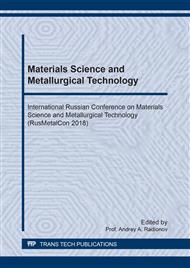p.883
p.889
p.895
p.901
p.906
p.913
p.921
p.928
p.934
The Comparison Research of Plasma Surface Hardening of 34CrNiMo6 Steel Produced on Direct and Reversed Polarity Current
Abstract:
Many product parameters are basically determined by the state of the surface layer of the material from which it is produced. Increasing the hardness of the surface layer with unique core characteristics will significantly improve the performance characteristics of products and expand field of application of 34CrNiMo6 steel. The paper presents the results of a study of the surface plasma hardening of 34CrNiMo6 steel on direct and reversed polarity current. Studies of four possible variants of plasma surface quenching, including processing with scanning and processing in closed arc mode were carried out. The results of measuring geometric characteristics and hardness of the produced hardened layers are given. The possibility of producing hardened layers with a hardness up to 52 HRC is shown. The macro-and microstructure of the produced hardened layers using light microscopy was studied. The features of structure formation in layers hardened in different variants are analyzed. It is shown that it is possible to produce hardened layers with a depth of 1.7 mm and a width of up to 24 mm in the finishing plasma treatment without significant changes in the surface roughness.
Info:
Periodical:
Pages:
906-912
Citation:
Online since:
February 2019
Authors:
Price:
Сopyright:
© 2019 Trans Tech Publications Ltd. All Rights Reserved
Share:
Citation:


